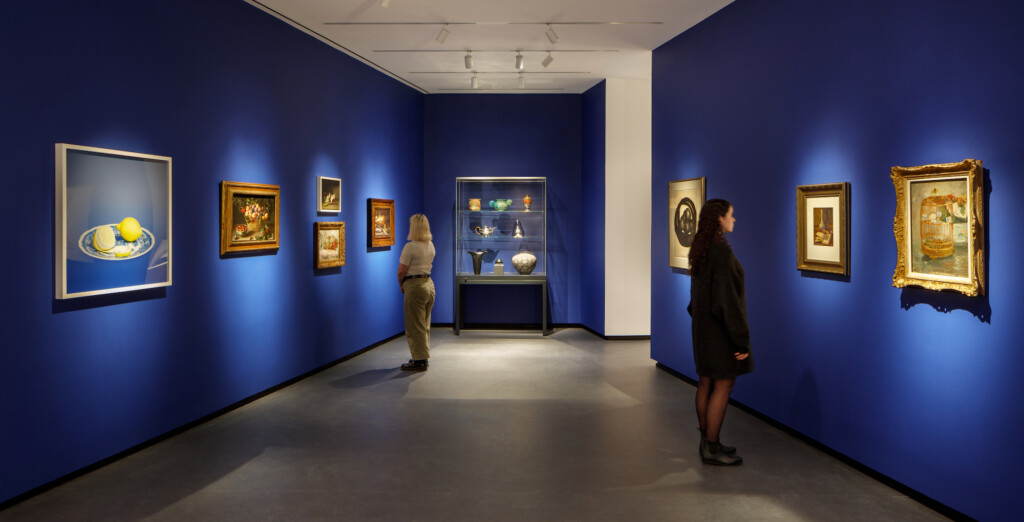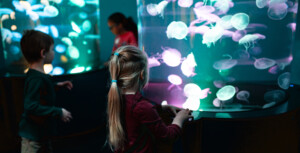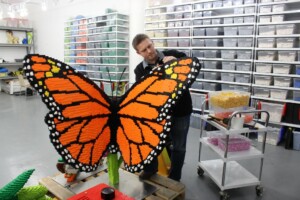The National Museum of Women in the Arts (NMWA) in Washington, D.C. reopened on 21 October 2023 after a $69 million renovation, completed by woman architects and conservators.
The museum first opened in 1987 as the only major museum in the world dedicated to championing women through the arts.
The renovation features exhibition space, reimagined galleries, and an updated performance hall, as well as new studio and classroom space. There is also revitalised infrastructure, including a refreshed façade. The NMWA’s new major exhibition, The Sky’s the Limit, celebrates the upgraded space, showcasing 33 large-scale sculptures.
Susan Fisher Sterling has been director of the National Museum of Women in the Arts (NMWA) since 2008. She joined the institution as associate curator in 1988, after graduating from Princeton University with a master’s and PhD in art history, specialising in modern and contemporary art.
A career in museums
As the museum’s curator of modern and contemporary art, chief curator, and deputy director, she produced exhibitions and publications on a range of contemporary women artists. This included well-received international shows focused on the art of Brazil and postmodern photography.
Under her leadership, the NMWA has developed into an international force that spotlights women artists of all periods and nationalities, growing its collection to more than 5,000 works. She has instituted public programs such as the Women, Arts, and Social Change initiative. Sterling has solidified NMWA’s reputation as a trailblazer, thought leader, and fierce advocate for women artists from every genre and era.
“My career path probably begins in sixth grade,” she tells blooloop. “I went to a progressive public high school and had a semester at the end of my senior year where I was able to have a long-term internship at the Cleveland Museum of Art and to research a collection of 18th-century fans and porcelain. This gave me an appreciation for the decorative arts.
“It also gave me an inside look at the workings of museums, which compounded my childhood memories of going to the Cleveland Museum of Art for art classes when I was quite young. My mom had three kids and needed a break. She sent me, as the eldest, to the museum for classes on Saturday morning. That combination made me feel very comfortable in museum settings, especially before and after hours.”
Sidelining women in art
She was in graduate school when she became aware of the sidelining of women in art:
“We were doing a class on abstract expressionism. When my advisor started the class, he laid out the curriculum. I commented: ‘Why don’t we look at people like [Lee] Krasner and [Joan] Mitchell?’
“He said, ‘Yes, that’s good. We’ll use them as comparative material.’ That was the moment when I realised that I was working in a different universe.”
It was, she contends, an incredibly important education:
“It taught me a kind of critical thinking that made me question what I was being taught.”
Throughout history, when women became artists, they generally had to overcome formidable obstacles to do so. To what extent has the field now been levelled?
“I often say this,” she responds. “The world likes to think it is achieving parity or equity a lot more quickly than is the case. When you look at the gallery system, when you look at museum shows, when you look at the work of Charlotte Burns and Julia Halperin [the Burns Halperin Report explores representation in US museums and the international art market], you recognize that you may start with this kind of 50:50 proposition. But when you look at what happens as you move along the career path, you see that there’s a diminishing rate of return.”
A new shift
There has been some improvement, she concedes:
“The circumstances of education certainly have changed from the time of Lavinia Fontana in the 16th century, or even the 19th century, before Académie Julian and others allowed women. Education has changed. But that doesn’t mean that success in the art world has moved nearly as far as the educational system has.”
The Burns and Halperin report is available in the advocacy section of the NMWA website:
“We create memes from it that you can use. We see ourselves as the disseminator of important information that shows the playing field is not level, and isn’t close, especially in terms of auction and collecting.”
It is not all bad news, however:
“Something that has shifted a lot is the number of women in senior positions in the cultural sector in the US.”
Additionally:
“My colleagues are doing a lot of work with women artists, including the National Gallery of Art under Kaywin Feldman, the Hirshhorn Museum under Melissa Chiu, the Smithsonian’s National Portrait Gallery under Kim Sajet, and the National Museum of American Art under Stephanie Stebich. They all have an avowed aim of creating an exhibition and collection program that involves more women and more people of colour.
“Things are certainly changing, and it’s something we are all in favour of.”
The National Museum of Women in the Arts
The National Museum of Women in the Arts was the brainchild of Wilhelmina (‘Billy’) Cole Holladay.
“She and her husband Wallace were collectors. In the seventies and early eighties, they focused their collection on women artists, for a couple of reasons. Firstly, they saw a need. Secondly, they had modest means for collectors at the time. They understood that while there was value in great paintings, art and sculpture by women artists, the prices were very low.”

They were, therefore, able to build an exceptional collection of the art they liked – mostly European, with a focus on Mrs Holladay’s preference, 18th Century French art – for their house:
“The collection was pretty astonishing for the story that it told,” she says. “The key came when Nancy Hanks, the first head of the National Endowment for the Arts here in Washington, who spoke with Mrs. Holladay regularly, said to her, ‘Every time I go to a museum as part of my job, I ask them to see the women artists hanging on their walls. There are maybe one or two, if that. You need to do something about this. Why don’t you think about beginning a museum?’
“At first, she was not interested. She was a docent at the National Gallery and wanted to give the works to that institution. Then some foolish curator, when asked, ‘How many works would be on view at any time?’ said, ‘Well, we’d show a few, and rotate them through the collections.’”
Celebrating the collection
The idea that, after dedicating so much time to this important work, her collection would be relegated to the basement – where many of the works had been already – was, in conjunction with encouragement from people outside Washington, including some major collectors, the seed of the NMWA.
First, however:
“She had to have proof of concept. So, she started to travel and to talk to lots of women’s groups. She also started to open up her house to people to come through every Thursday, and see the collection.”
In 1981 all these factors came together sufficiently for her to realise there was an interested membership and people who were interested in giving funds to start the museum.
“They found a building not far off of the main path of the federal museums,” Sterling adds. “People were coming to her and saying, ‘This is a visionary notion.’ So here you have this person who is not necessarily a feminist, and who actually says outright that she’s not because her goal is to enfranchise as wide a swath of people as possible. That created a lot of controversy. And controversy is good, because it puts you on the map, as Mrs H used to say.”
In short, she adds:
“The museum was born of some conservatism, some commercialism, and lots of controversy.”
Championing women in and through the arts
Initially, Mrs Holladay was pilloried from all sides. However, the media coverage of the museum’s reopening in October last year shows that Mrs. Holladay is, at last, being given her due:
“Before she died a couple of years ago, she had already seen the reception of the museum and the way it was viewed. She lived long enough to feel that all that faith, time, wealth and talent that she and others had put into it, was worthwhile. It was a visionary idea, and perhaps even more important than she had realised.”
Even now, there is controversy. Sterling recognises the museum’s need to stay in touch and change with the times:
“We have talked a lot internally and have embraced non-binary, which makes tremendous sense for us, on the terms of those non-binary individuals and what they desire and want from an institution like ours. I think that, perhaps, is the most important shift over the last few years.
“Around seven, or eight years ago, we moved from Mrs Holladay day’s idea of the museum. She wanted ‘to reinsert women into the history of art.’ “
Some years ago, after much discussion, the museum changed its core principle to ‘championing women in and through the arts’:
“As I like to say, there’s a broader mandate here.”
Art and advocacy at the National Museum of Women in the Arts
The art and the advocacy, the museum and the megaphone, are key:

“I think about this a lot, especially as we do diversity, equity, inclusion and accessibility work at the museum. This is very much at the forefront of how American US museums are changing. Striving to be a more user-centric, welcoming and forward-directed place is part of what we have always been, but we would like to continue to lead.”
Accordingly:
“There are things we need to double down on, that other institutions may not choose to.”
She elaborates:
“In terms of our programming, one of the bases of our collection policy is to make sure that the collection is more representative of diversity. When it comes to gender, our goal is not to necessarily include men, because that’s not our focus, but it is to be able to include all those who identify as women, and those who may be non-binary, who identify with the museum and its mission. Women, of course, have always been a part of who we are.”
Part of this involves growing the collection so that when people visit, they see themselves represented.
“That is a concept in the US that has been around for a long time,” she remarks. “It’s hard to get there. I think we’ve done the best with our collection as it stands now in terms of doing that upon reopening, showing what we’ve been collecting.”
A non-chronological approach
The NMWA does not believe, she points out, in the hierarchy of the arts established from the French Academy onward. Therefore,
“We probably show less painting and sculpture than most other institutions. We show a lot of what is called ‘decorative arts’, but we don’t see it as that. There is a real frazzling in contemporary art of those distinctions between fine art, decorative arts, textiles, et cetera. We have embraced that since the beginning. As far as a good chunk of our exhibition program is concerned, we don’t believe in those boundaries.”

“We show works of all different types, and we show them together. When we do our installations of our collection, a point of controversy for some critics (although artists seem to love it) is the fact we don’t show our collection chronologically. If you were to come into the museum collection galleries, and you were looking to begin at the 16th century and continue up to contemporary art, you would not find that.”
Instead:
“What you would find is nine thematics.”
Themes at the National Museum of Women in the Arts
NMWA’s thematic installations contrive, by mixing works across time and place in innovative groupings, to transform visitors’ perceptions of art and its creators. Sterling identifies two reasons why the museum has chosen to hang thematically:
“One is because chronology tends to cheat women and people of colour, because we show up in greater numbers at the end – I don’t want to call it the end, but now. That doesn’t help us.”

“The second thing is that if you work thematically, you can myth-bust in a really important way. For example, one of our other nine themes is ‘Photo Credit’. Here, we give credit to the women progenitors of photography.”
‘Elemental’ highlights the work of modern and contemporary artists who perceive earth, air, fire, and water as creative forces:
“‘Landmarks’ does the same thing. Women were seen as associated with the land and nature, and not as part of rationality or creativity in the male ‘genius’ sense.”
Visitors become part of the story
There are short explanations for each of the themes:

Installation view of a work by Beatriz Milhazes in The Sky’s the Limit at the National Museum of Women in the Arts. Photo by Jennifer Hughes, courtesy of NMWA
“The great thing when someone comes into the thematic area is that they get to make sense of it themselves. They get to provide their own narrative. We’ll guide them – we have QR codes that they can access as well as other kinds of information that they can connect to. But they become a part of the story-making.”
It is an essentially user-centric interpretation.
She adds:
“One of the criticisms is that chronology is important for establishing a sense of the march of history and that women become more important toward the modern period. Our feeling is that if women are important in the modern period, then show it differently.
“I love the way we’ve done it. And artists love it because as the galleries are laid out, they see their work in conversation.”
A new layout for the National Museum of Women in the Arts
Previously, the MNWA was a rabbit warren of galleries. Now, post-refurbishment, it is a series of small galleries. These are aligned in a way that creates intimacy while affording a view that allows connections to be made across different galleries.
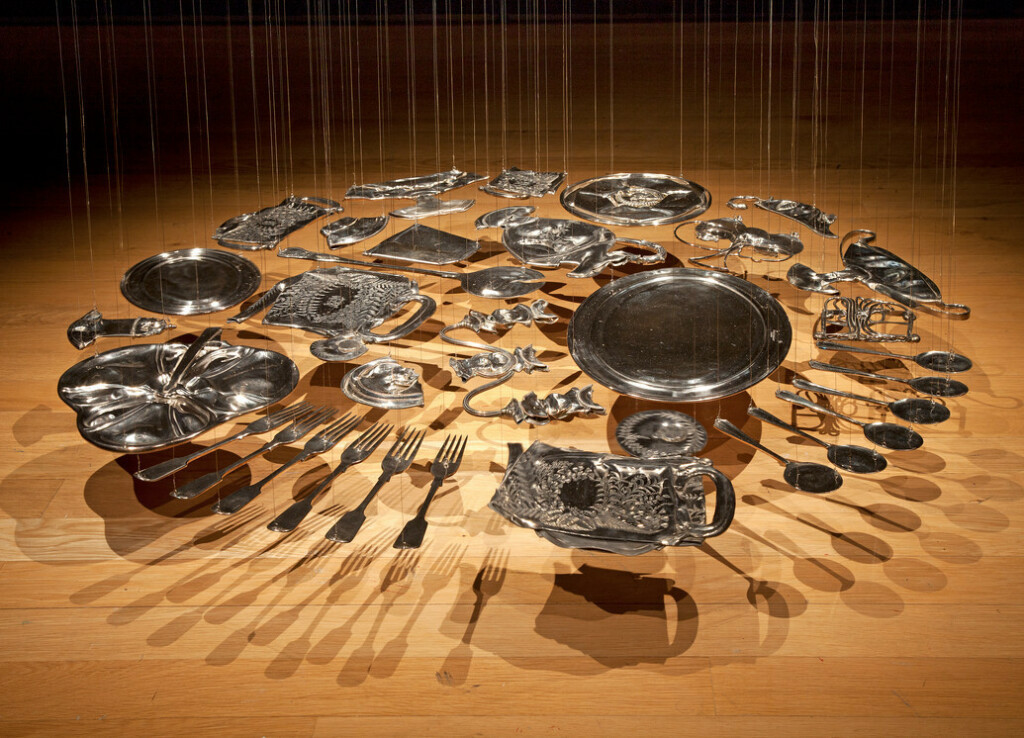
“Now you can see what’s coming next,” she explains. “You see this great Niki de Saint Phalle, Pregnant Nana (1993), at the front. It’s a joyous six-foot-tall figure, and you know you’re in for something else.”
The collection catalogue, which is also arranged by theme, presages what a visitor might see. However, the voices in the catalogue are not necessarily the traditional authorial ones of curators.
The Sky’s the Limit
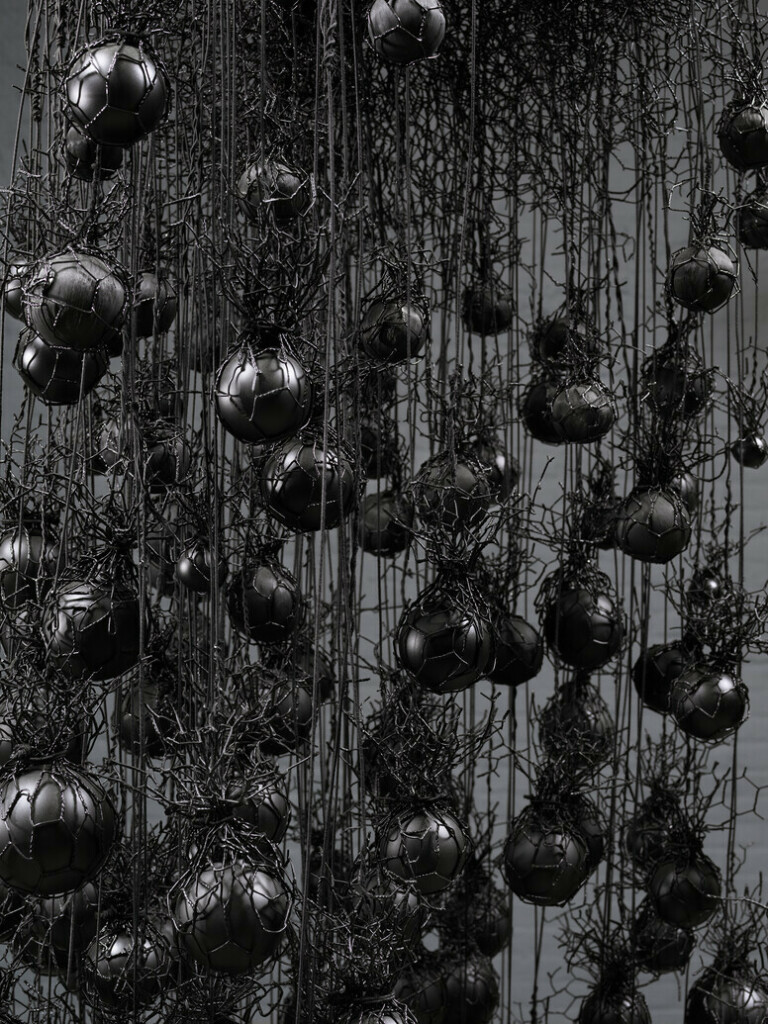
“The Sky’s the Limit, our exhibition on the second floor, is a series of amazing installations,” she adds, demonstrating:
“This is Rina Banerjee, one of the artists included in Sky’s the Limit. Here’s an example of Petah Coyne’s work, made out of wax and wire and various other materials from the world – or this beautiful Beatriz Milhazes work which we own. Then there are these fantastic bells by Davina Semo. We have an installation of seven or eight of them, and they can be interactive. There’s a beautiful Cornelia Parker – Thirty Pieces of Silver.”
“We also have a Mariah Robertson, an abstract, which is the largest photograph, we believe, ever made.”
Further powerful works in the exhibition are by Sonya Clark, Alison Saar, Shinique Smith, Johanna Unzueta, Joana Vasconcelos, Ursula von Rydingsvard, and Yuriko Yamaguchi.
Not just a muse
Kathryn Wat, deputy director for art, programs and public engagement/chief curator and her team have developed an exhibition where, as Wat is quoted on the NMWA website, “the artworks convey energy and dynamism that dovetails with the urgency of the museum’s mission to oppose historic and contemporary gender inequality. The pieces reach out to directly engage audiences and evoke a precariousness that is exciting.”
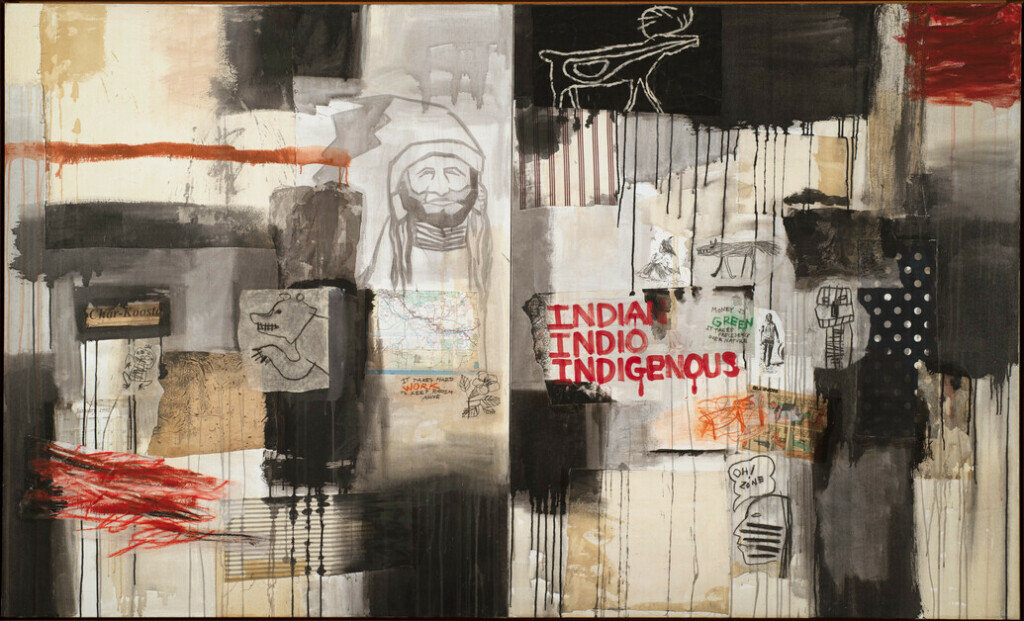
“These are not works that hang on the wall or sit on the floor,” Sterling comments:
“They dominate space, they take over space, they redefine it, they’re immersive, you walk around them. The key here is this idea that women work big, they work immersive, and they engage the viewer. We don’t need to be approved or okay-ed by the hierarchy as art on the wall or art on a pedestal. And we don’t want to be placed on a pedestal as a muse.”
